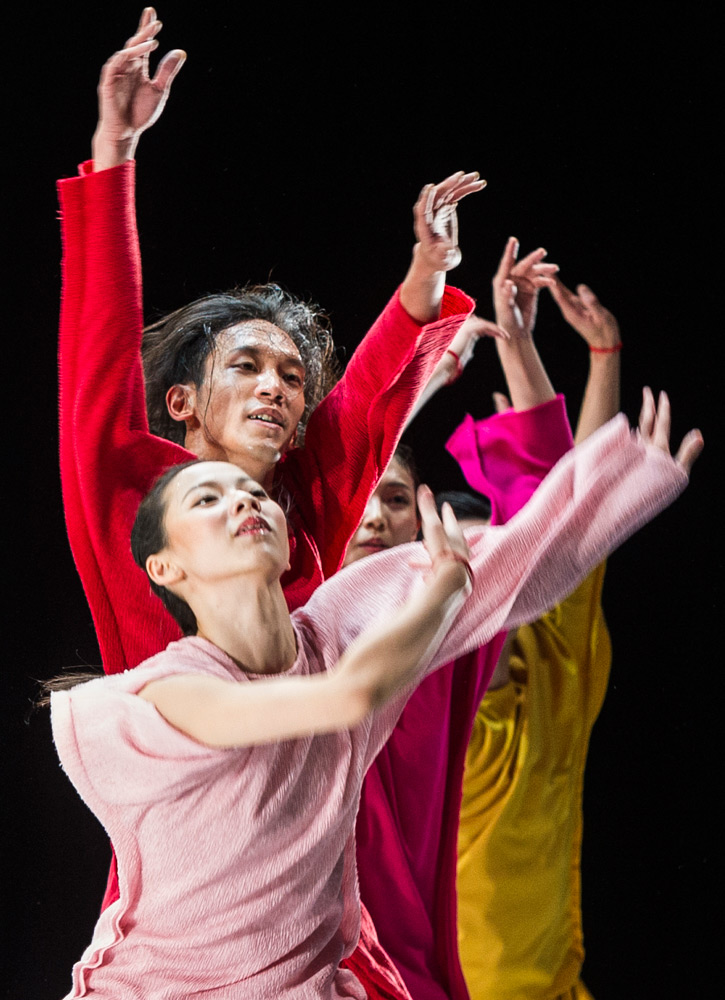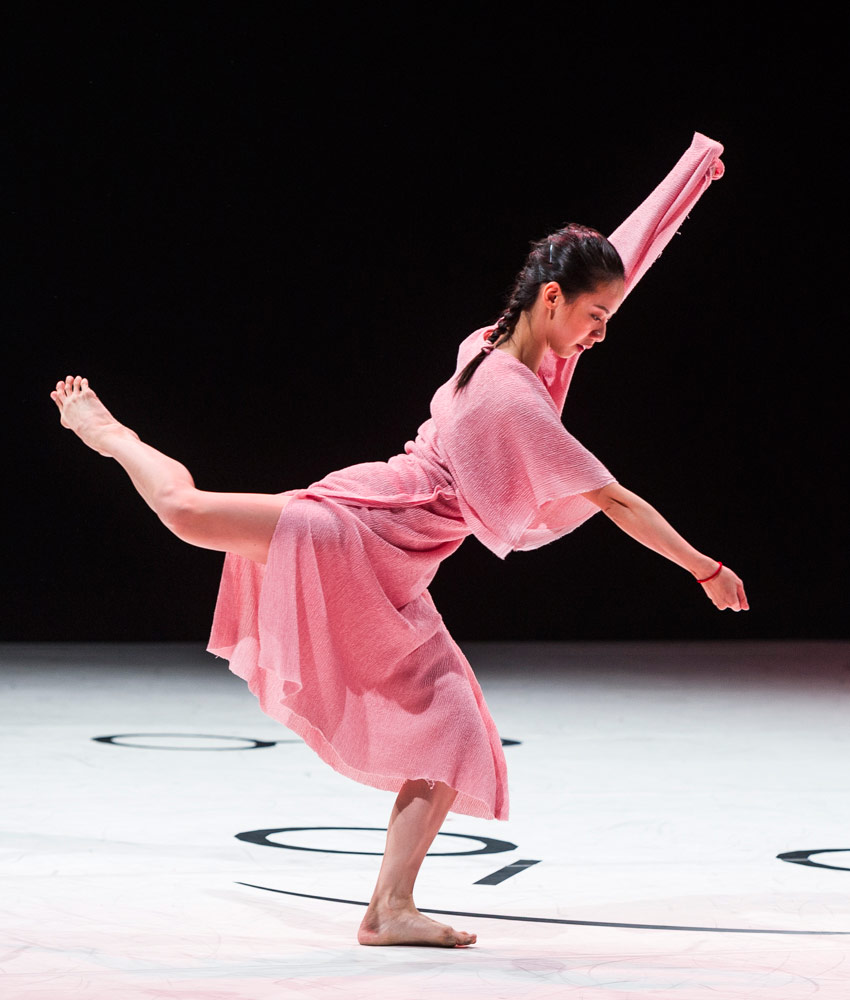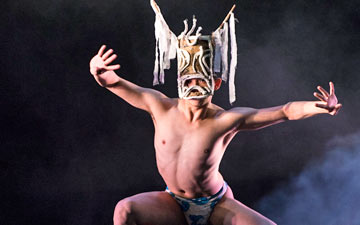
© Foteini Christofilopoulou. (Click image for larger version)
Cloud Gate 2
Wicked Fish, The Wall, Beckoning
★★★✰✰
London, Sadler’s Wells
21 November 2016
Gallery of Beckoning pictures by Foteini Christofilopoulou
www.cloudgate.org.tw
www.sadlerswells.com
As “junior” companies go, Cloud Gate 2 is well fledged. Created in 1999 as an adjunct to Taiwan’s Cloud Gate Dance Theatre, it provides opportunities for young dancers and choreographers whilst retaining a distance from the parent unit. Dancers do not migrate between the two companies. Whilst Cloud Gate is a regular visitor, appearing here at Sadler’s Wells as recently as May, this performance at Sadler’s Wells marks Cloud Gate 2’s debut in the UK.
Initially run by former dancer, Lo Man-fei, who died – after her long struggle with lung cancer – in 2006, Cloud Gate’s charismatic founder, Lin Hwai-min, ran both companies for the next eight years until Cheng Tsung-lung was elevated from the role of resident choreographer to assume the mantle of Cloud Gate 2’s artistic director, in 2014.
Cheng authored both the final works in this triple bill, while the brief opening piece was choreographed by Huang Yi, a regular contributor to Cloud Gate 2. This was an odd configuration to get my head around since the concluding work was considerably different from the two that came before. This has more to do with chronology than maker since the opening works premiered together, back in 2009, whereas the concluding piece, Beckoning, was made last year. Cheng himself is now a much-changed individual and the six year divide appears like an epoch in terms of the contrasting styles of his productions.

© Foteini Christofilopoulou. (Click image for larger version)
One can only marvel at the flowing control of these excellent dancers and the simple beauty and purity of the dance they presented. It was a tonic for those of us who love unadulterated, yet expansive, movement, particularly in Huang’s opening work, where a dozen dancers often moved with the swirling abandon of leaves rustling in an autumn breeze, mostly in unified patterns but occasionally – as in nature – with individuals rotating free from the clutch. My fanciful imagery, set above ground and on dry land, was misplaced since Huang’s stated intention was to mimic the collective movement of a shoal of fish.
Wicked Fish opened with sharp, impactful images of the dancers floating in and out of the light and Lee Chien-chang’s shimmering lighting designs were integral to the work’s transient beauty. Huang’s choreography is complex and precisely detailed across the twelve dancers’ interoperability in a well-structured work that relies on just a bare stage and black wall with silver-grey, fishy-coloured costumes, accentuated by darker blotches. The string-led score by the late Greek–born, French composer, Iannis Xenakis provided music that, although sometimes jarring in tone, integrated well with the layered movement,
The Wall presented an interesting mix of collective marching – like rhythmic drill exercises – and fluid individual dancing. Most dancers were dressed uniformly in black, thus reinforcing the militarism, further accentuated by the heavy beats in Michael Gordon’s score. The choreographer is on record as saying that the work was made at a time of his “inexplicable depression” and creating The Wall enabled him to overcome a self-induced state of reclusion.

© Foteini Christofilopoulou. (Click image for larger version)
Perhaps to represent this escape from uniformity, the underlying theme of Cheng’s intention appears to focus on individuals escaping from the routines of the group, the main articulation of which is to disaggregate a couple from the crowd, delineated by contrasting costumes (including a simple white shift dress for the lead woman). Beautiful though the movement patterns were, The Wall gradually evolved into a structure metaphorically made of blast-proof concrete in its impenetrability.
Both these earlier works had little overt design input beyond the dark aura of the lighting and while the movement was often arrestingly attractive, there was little stage charisma in the performance. The newest work, Beckoning, was more playful and had a naïve stage design in He Jia-sing’s white floor containing some simple symbols; appearing to be the eyes, nose and mouth of a misshapen “smiley” face, having lost an “armless” pair of spectacles, and facing a mysterious black hole, so realistic that I thought dancers might fall through it!
Cheng’s inspiration for the work came from witnessing the street dancing rituals of Taoist temple parades in his childhood, notably the ritual of ba jia jiang (the ‘Eight Infernal Generals’) and – so I also read – from ji tong, a form of shamanism where mediums are possessed by the spirits of gods during religious observance.

© Foteini Christofilopoulou. (Click image for larger version)
At around 20 minutes, Beckoning might have remained absorbing but it was unfortunately twice that long – far too long – with too many layers of different and unclear concepts. This resulted in a fragmented and incoherent work, which is a shame because, again, the quality of movements ricocheting through the dancers’ bodies was often beguiling.
It was also a shame that the visit of a new and exciting company from Taiwan was represented by a photo-copied piece of paper as the official programme. Identifying unknown dancers was therefore an impossibility and those that I might have wished to credit will have to remain anonymous. Unfortunately, the cloak of dark anonymity washed over the whole programme in stark contrast to the dancers’ exhilarating skill.

















You must be logged in to post a comment.